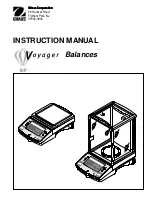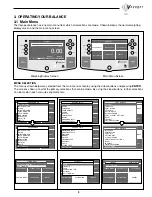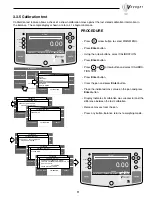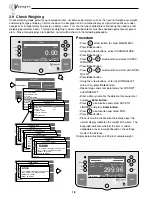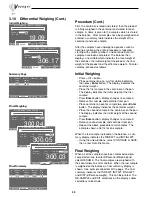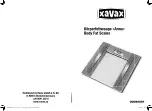
6
3.2 Turning On the Balance
The Voyager balance is ready to operate after the the installation procedures are performed. When the balance is
first turned on and it completes its checks, and is calibrated, it can be used to weigh or tare materials without setting
the menus. The balance is preset at the factory to weigh in grams
It is recommended that you read this manual carefully and set the balance to operate for your specific applications
using the procedures in Chapter 4 Setting up Your Balance and calibrate the balance before using.
LCD Display On/Off
To turn the balance LCD display ON, press the ON/OFF button (circled button with an I inside) located at the upper
left-hand corner of the panel once. To turn OFF, press button again.
Stabilization
Before initially using the balance, allow time for it to adjust to its new environment. The balance only requires to be
plugged in to warm up. Recommended warm up period is twenty (20) minutes. The internal circuits of the balance
are powered whenever it is plugged into a power source.
CALIBRATION MASSES
LINEARITY SPAN ONLY
CAPACITY MASSES
MASSES
62g
20g/50g
50g
110g
50g/100g
100g
210g
100g/200g
200g
410g
200g/400g
400g
610g
200g/500g
500g
2100g
1000g/2000g
2000g
4100g
2000g/4000g
4000g
6100g
2000g/5000g
5000g
8100g
4000g/8000g
8000g
Masses must meet or exceed ASTM Class 1 Tolerance.
Calibration masses are available as accessories.
Calibration Menu Protection
NOTES
:
• Calibration may be locked out to prevent unauthorized
personnel from changing calibration. If calibration has
been locked out, you can only access Internal Weight
Calibration and Calibration Test.
• To lock out calibration menu, after calibration, refer to
the section titled Menu Lock-Out Protection.
• Linearity, Span and User calibration are disabled for
Type Approved/LFT balances.
Calibration Masses
Before beginning calibration, make sure masses are
available. If you begin calibration and realize calibration
masses are not available, exit the menu. The balance
will retain previously stored calibration data. Calibration
should be performed as necessary to ensure accurate
weighing. Masses required to perform the procedures
are listed in the adjacent table.
3.3 Calibration
Voyager balances offer a choice of five calibration methods: Automatic Calibration (AutoCal
TM
), Span Calibration, User
Calibration, Linearity Calibration, and Calibration Test.
•
Span
-
Span calibration ensures that the balance reads correctly within specifications using
two weight values: zero and a weight value at 100% of the balance’s full capacity.
•
Linearity
-
Linearity calibration minimizes deviation between actual and displayed weights within
the balance’s weighing range. Three weight values are used: zero, a weight value at
midpoint of the balances weighing range, and a weight value at or near the balance’s
specified capacity.
•
User
-
User calibration is a method where the balance can be calibrated using a mass of
known value by entering that value into the balance.
•
Calibration Test
-
Calibration test allows the stored calibration data to be tested against the current
mass being used for the test.
•
AutoCal
TM
Automatic calibration (AutoCal
TM
) of the balance is accomplished by an internal
mass.
Summary of Contents for Voyager V10640
Page 61: ...55...
Page 62: ...56...
Page 65: ...1 Ohaus Corporation 29 Hanover Road Florham Park NJ 07932 0900 Operating instructions balances...
Page 154: ...Operating instructions balances O T O T O T O T OHAUS...
Page 243: ......
Page 245: ......

